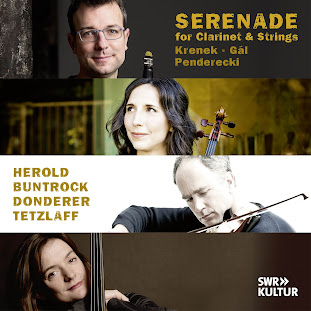The Serenade is in two
movements, however the second has five sections, which in this recording are
labelled individually. It is in a late romantic style, with some neo-classical
overtones. Yet here and there, Krenek becomes harder edged, reflecting the post-First
World War situation. Overall, the mood is lyrical and approachable. Many years ago,
the critic Tom Cleman remarked that the stylistic parameters are “delineated by
the landmarks set up by Claude Debussy, Max Reger, Richard Strauss, and perhaps
Alexander Scriabin.” This holds good, but I would add that there are hints of
expressionism, as exemplified by the slow movement’s nod to Arnold Schoenberg’s
Verklärte Nacht.
This is a world premiere
recording. It is splendidly played by the present ensemble, who are great
advocates for this “forgotten” piece.
Hans Gál was a Viennese composer, who like Krenek found it impossible to live under the Nazi regime. In 1938 he fled to Britain, was interned, but later took up residence in Edinburgh. At the behest of musicologist Donald Tovey, he worked at Edinburgh University, where, in 1945 he was appointed a lecturer. Without being demeaning, much of Gál’s catalogue could be regarded as being “retro.” He looked back rather than forward in his aesthetic. Brahms had a major impact, but so did the “playful humour of early classicism,” and the “extended tonality of early 20th century music.” He never adopted serial technique. His music is nearly always lyrical and restrained.
The present Serenade for
clarinet, violin and cello, op.93 is a pre-war piece, having been written in
1935. Its four movements are typically relaxed. The opening Cantabile
balances an almost pastoral opening with a prickly second subject. The scherzo,
Burletta, is the other way round. Here the ‘trio’ presents the lyrical mood
whilst the ‘minuet’ section is sarcastic and dark. The slow movement, a short Intermezzo
is lugubrious, with its pizzicato strings and sad melody. This leads to a
cadenza, before the Giocoso brings the Serenade to a happy-ever-after
conclusion, but not before a lovely little tune is expounded.
People of a certain age will recall Krzysztof Penderecki’s impact as an innovative disciple of the avant-garde. Making his name with the Threnody to the Victims of Hiroshima for string orchestra (1960), and later the St Luke’s Passion (1966) he used various techniques such as the “juxtaposition of sound masses,” extended instrumental techniques and graphic scores. Yet, in the mid-1970s his style made a major change. To the chagrin of his progressive fans, he looked back to Bruckner and Liszt for inspiration. An early indication of this was his 1977 Violin Concerto.
The Quartet for clarinet, violin,
viola, and cello was completed in 1993. Penderecki declared that he had been
encouraged to write the Clarinet Quartet after “rediscovering Schubert’s great
C major Quintet” while attending a concert of that work performed by Mstislav
Rostropovich and the Emerson Quartet. Although not a precise model for the
present piece, both share a sense of melancholy and tenderness.
The opening movement’s gentle
dialogue between clarinet and viola provides a sad start. The Scherzo is
rapid, quicksilver and is followed by a parody of a Viennese waltz. The final
movement, Abschied, does echo the elder composer’s sadness visible towards
the end of his life.
In preparing for this review, I
came across an excellent summation of the Clarinet Quartet’s stylistic
parameters: “[it] creates the impression of a retrospective of European art
music from the first half of the twentieth century, perhaps the missing link in
Penderecki’s own oeuvre.” Composers that have infused this Quartet are
Beethoven and Schubert, but also that of Schoenberg, in its wayward waltz, and
even Alban Berg. In this Quartet, Penderecki combines austerity of sound with a
deep emotional statement. It was premiered on 13 August 1993 in Lübeck,
Germany.
The star of the show is clarinettist, Kilian Herold, but the three other performers are integral to the disc’s success. The liner notes by Johannes Jansen give an outstanding introduction to the music, concentrating on context. The recording is clear, dynamic, and well balanced.
These are convincing accounts that explore these rare but rewarding works.
Track Listing:Ernst Krenek (1900-91)
Serenade for clarinet, violin, viola and cello, op.4 (1919)
Hans Gál (1890-1987)
Serenade for clarinet, violin and cello, op.93 (1935)
Krzysztof Penderecki (1933-2020)
Quartet for clarinet, violin, viola, and cello (1993)
Kilian Herold (clarinet), Florian Donderer (violin), Barbara Buntrock (viola), Tanja Tetzlaff (cello)
rec. September/October 2021, Hans-Rosbaud-Studio, SWR Kultur Baden-Baden, Germany
AVI Music AVI8553537
With thanks to MusicWeb International where this review was first published.

No comments:
Post a Comment